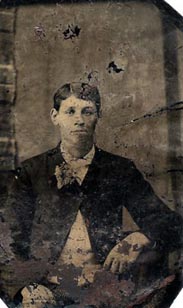Sign up for the Family Tree Newsletter Plus, you’ll receive our 10 Essential Genealogy Research Forms PDF as a special thank you!
Get Your Free Genealogy Forms
"*" indicates required fields
Shirley Holdahl owns this deteriorating tintype, and she wants to know if there’s a way to save it. Anyone with a photo in poor condition has probably wondered the same thing. The answer is yes! Let’s look at the options.
First on the list is identifying the person in the image. Holdahl thinks this gent is one of three relatives, and date clues help narrow the possibilities. Tintypes were first patented in 1856 and remained common in some areas into the 20th century. The man’s narrow-fitting jacket, striped trousers and very short hair were stylish in the 1880s. The flower in his lapel suggests this photo was taken for a special occasion, perhaps a graduation. Holdahl can use life dates for the three candidates, then compare them to an estimated age for this fellow—I’d put him in his mid to late teens.
Tintypes are durable iron images, but their composition also leads to the types of deterioration seen here. Abrasion due to storage with other items causes pieces of the emulsion (image) to flake off. Humidity in the air then leads to rust where the iron plate is exposed. As this image ages more rust appears and the flaking will continue eventually destroying the picture. There are several things Holdahl can do to keep this image safe for future generations. What does depends in part on her budget.
Preserving the Image
Right away, Holdahl should purchase an acid- and lignin-free folder to store the tintype, and keep it in a place with stable temperature and humidity levels. This will slow the rate of deterioration. Appropriate materials are available from art supply stores and library suppliers, such as Archival Methods and Hollinger Corp.

Holdahl could preserve the image digitally and fix some of the damage with a photo-editing program. Within a few minutes I was able to replace some of the missing pieces of this gentleman’s face using Microsoft’s Digital Image Pro 10.0. It’s not perfect, but it looks better than it did. Photo-editing software often comes packaged with scanners and digital cameras, and some scanners automatically correct some blemishes as it scans. For more information on scanners and scanning, see Digitizing Your Family History by Rhonda R. McClure (Betterway Books, $19.99). You’ll find instructions for editing your photos in the April 2004 Family Tree Magazine.
Professional Restoration
Professional photo-editors and graphic artists often specialize in restoring damaged images either by working with a digital file or airbrushing a copy photo. None of these processes change the original—Holdahl would receive a new-and-improved copy of the original photo. Look for more details on these methods in my book Preserving Your Family Photographs (Betterway Books, $19.99). The cost of these services varies by technique, so call around and ask your fellow genealogical society members for recommendations.
Conservation
If Holdahl wants to stop further deterioration to her tintype, she’ll need to hire a professional photo conservator. The American Institute for the Conservation of Historic and Artistic Works offers a free referral service under the heading Public Information. Costs depend on the type of photo and damage.
Photo editing and restoration provide you with a “better-than-new” copy, while conservation actually prevents future problems. Before hiring any professional or expert, ask for a free estimate, references and work samples. <!–
Conservation
normal text –>
Find out how to submit your own picture for possible analysis by Maureen Taylor. E-mail her at mtaylor@taylorandstrong.com.
ADVERTISEMENT

